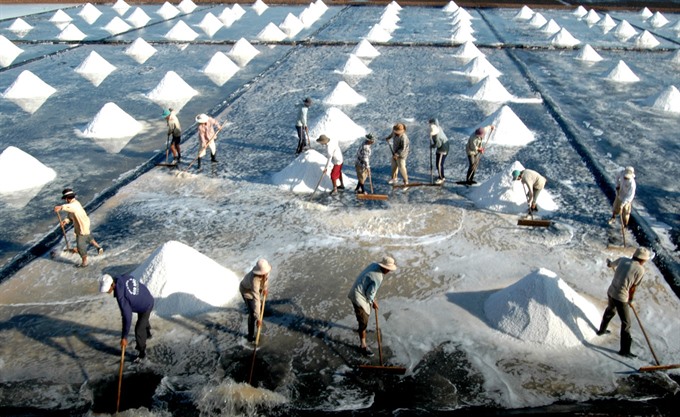 Economy
Economy

On the domestic market, salt price has been on the rise for a few consecutive days, while many salt farmers express their dissatisfaction at having ran out of salt supply during the price hike.
 |
| Sea salt harvested in Bạc Liêu Province. — VNA Photo Huỳnh Sử |
HÀ NỘI — Domestic salt prices have been on the rise since the beginning of March, and many salt farmers have expressed their dissatisfaction after running out of salt during the price hike.
In southern Bạc Liêu Province, the current buying price for salt has increased by 100 per cent from the beginning of this year’s salt harvest. In particular, black salt is selling at VNĐ700 to VNĐ900 (US$0.03 to $0.04) per kilogramme and regular salt at VNĐ1,200 to VNĐ1,300 per kilogramme, as compared to the VNĐ500 to VNĐ600 and VNĐ250 to VNĐ500 at the same time last year, respectively.
Nguyễn Hoàng Thưa, deputy chairman of the Doanh Điền Hamlet Salt Co-operative in Bạc Liêu Province, reported that salt inventories at the co-operative and many other farms had been cleared. He also stated that despite the high demand and price, farmers were still not making much profit due to low productivity.
According to Võ Hoàng Nghiệp, a salt farmer from Đông Hải District, Bạc Liêu Province, the initial low price at the harvest’s beginning was too unappealing for farmers to produce a larger amount.
Another reason for decreased salt supply this year is the large amount of residual inventory from last harvest, which caused salt farmers to convert their salt farms to aquacultural farms, said Dương Chí Thanh, Deputy Head of Division at Bạc Liêu provincial Department of Agriculture and Rural Development.
Unfavourable weather conditions, such as a prolonged rainy season, further decreased supply by shortening harvesting time and limiting the coastal areas reserved for sea salt farming by 50 per cent compared to last year.
On estimate in Bạc Liêu Province alone, the 2016 to 2017 salt harvest spanned only 1,700 hectares instead of the usual 2,300 hectares. Output is down by 30 per cent from the 2015 to 2016 harvest, currently at more than 165,00 tonnes. — VNS




